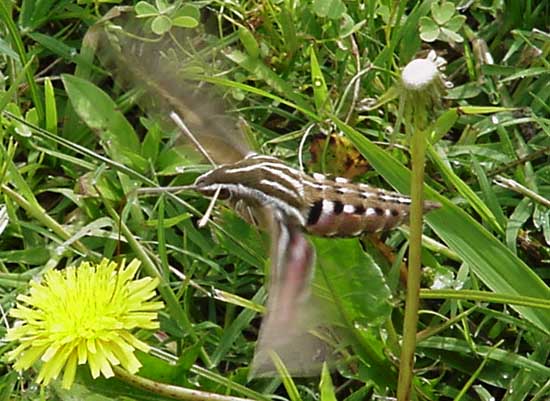Sphinginae subfamily
Sphingini Tribe:
 |
This large bodied moth flies in tobacco fields and vegetable gardens
(potatoes, tomatoes) and wherever host plants are found.
|
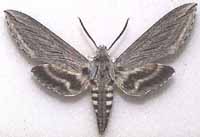 |
The upperside of the forewing is pale silver-gray with a series of
black dashes, a white patch at the tip, and a white stripe along the
outer margin. The upperside of the hindwing is black with blurry
white bands.
|
 |
Sphinx chersis
WO, the Northern Ash Sphinx or Great Ash Sphinx
The upperside of the forewing is soft dark gray to blue-gray
with a series of black dashes, one of which reaches the wing tip.
|
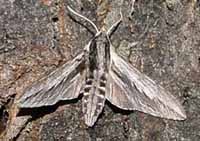 | Sphinx dollii (Wing span: 1 3/4 - 2 1/2 inches (4.5 - 6.3 cm)),
flies in arid brushlands and desert foothills.
|
 |
The costal area in the basal and median areas of the forewing is light grey. This colour also
appears in the terminal area. The rest of the wing is dark slatey grey.
|
 |
The upperside of the forewing ranges from brown with black borders
through brownish gray with paler borders to pale gray with no
borders. Dashes, submarginal line, and cell spot are usually weak.
|
 |
Sphinx luscitiosa
WO,
the Canadian Sphinx or
Clemen's Sphinx:
The upperside of the forewing is yellowish gray in males and pale gray with a faint yellow tint in females. In both sexes,
the dark border on the outer margin widens as it approaches the inner margin.
The upperside of the hindwing is deep yellow in males, pale yellow in females; both with a wide black border.
|
 |
The upperside of the forewing has a narrow black subterminal line
bordered by a white inverted V-shaped line on the outside, and a
black line running inwards from the apex of the wing.
It is most often found in montane woodlands and along streamcourses. |
Smerinthini Tribe:
 |
Pachysphinx modesta
WO,
the Modest Sphinx or Poplar Sphinx.
The forewing is grey brown with diffuse lines.
The hindwing is bergundy with dark blue to black markings near the anal angle.
|
 |
This one is quite similar to Pachysphinx modesta, with modesta
being smaller and darker.
Forewing lines are more distinct in P. occidentalis as compared
to P. modesta.
There may be naturally occuring hybrids in Laramie.
|
 |
This small species is widespread and common and is likely present. This species ranges across North America.
The hindwings have a small blue eyespot ringed with black on a yellow background.
|
 |
If you have willows and poplars nearby, you've probably got populations of
the Cerisyi's Sphinx. The hindwings are quite striking.
|
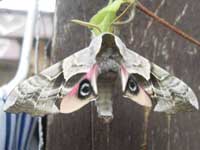 | Larvae feed on poplars, aspen and willows.
Note different shape of double arced forewing pm line compared to the straighter pm line of cerisyi, directly above.
S. ophthalmica has smoother scalloping of the fw outer margin.
|
Macroglossinae subfamily
Dilophonotini Tribe
 |
Hemaris senta
WO,
the Rocky Mountain Clearwing,
There is probably a single brood of this montane species from
May-August. The moth is seen along streamsides and in meadows in
mountainous areas.
|
Dilophonotini Tribe
 |
The forewing is light grey and brown with many lines, and there are dark patches near the middle of the inner margin, near the apex and near the anal angle.
The entire basal area of the hindwing is pink.
|
Macroglossini Tribe
 |
Hyles gallii
WO,
the Bedstraw Hawk Moth or Gallium Sphinx
This forewing is dark brown with a slightly irregular cream-coloured transverse line.
The outer margin is grey. There is a bright pink band on the hindwing.
|
 |
Hyles lineata
WO, the White-lined Sphinx
This species is very widespread. It can be seen flying during the day,
into the evening and also at night.
The highly variable larvae are often found in people's gardens. |
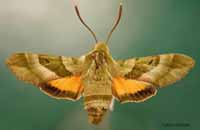 |
This day flier, April-June, prefers oak woodland and pine-oak
woodland in foothills. Moths nectar at a
variety of flowers in the afternoon.
|
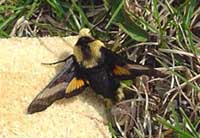 |
Proserpinus flavofasciata
WO, the Yellow-banded Day Sphinx.
The upperside of the forewing is medium to dark brown with a faint to distinct
white median band. The upperside of the hindwing is dark brown with a wide orange median
band which may not reach the inner margin. The moth mimics a bumblebee.
|
|
|
